Cultivating Resilience: Strategies to Mitigate Climate Change Risks in Indian Agriculture
DOI:
https://doi.org/10.63258/ajare-b70dse49Keywords:
Climate change, Indian agriculture, crop yields, temperature rise, rainfall patternsAbstract
Climate change presents a substantial risk to Indian agriculture, a vital industry for the nation's economy and lives. The industry is acutely responsive to fluctuating weather conditions, as elevated temperatures, modified precipitation and escalating water shortages detrimentally impact agricultural output, soil integrity and food security. Rising temperatures diminish yields, especially for temperature-sensitive crops such as rice, while unpredictable rainfall patterns result in waterlogging, droughts and crop failures. Water shortage exacerbates agricultural practices, requiring the use of effective irrigation techniques. Soil erosion and insect infestations further diminish agricultural yield. Strategies for adaptation, including the development of drought-resistant crops, the promotion of multi-cropping systems and the implementation of sustainable agricultural practices, are crucial for alleviating the effects of climate change. Technological innovations in precision agriculture, climate-resilient farming and enhanced meteorological forecasting, along with supporting measures such as crop insurance, may assist farmers in effectively managing climate-related risks and fostering resilience. Confronting these problems requires a comprehensive strategy that integrates innovation, sustainable practices and legislative assistance to guarantee enduring agricultural sustainability under climate change.
References
Aggarwal PK. et al. Climate Change and Agriculture in India: Impacts, Adaptation and Mitigation. Indian Journal of Agricultural Sciences, 2004;74(8):397-406.
Pirtilla AM, Koskimaki. biofertilizers and biocontrol agents for agriculture: How to identify and develop new potent microbial strains and traits. Microorganisms, 2021;9(4):817
Anonymous. Pradhan Mantri Fasal Bima Yojana - Crop Insurance, 2025. | PMFBY - Crop Insurance. [Cited 3 March 2025]. https://pmfby.gov.in/
Baumgard LH, Rhoads RP, Rhoads ML, Gabler NK, Ross JW. Impact of Climate Change on Livestock Production. In: Environmental Stress and Amelioration in Livestock Production, Springer-Verlag, Germany, 2012, 413-468.
Birthal PS, Khan T, Negi DS, Agarwal S. Impact of Climate Change on Yields of Major Food Crops in India: Implications for Food Security. Agric. Econ. Res. Rev. 2014;27:145-155.
Flores JHN, Faria LC, Neto OR, Diotto AV, Colombo A. Methodology for determining the emitter local head loss in drip irrigation systems. J. Irrig. Drain. Eng. 2021;147:06020014.
Pellegrini G, Ingrao C, Camposeo S, Tricase C, Contò F, Huisingh D. Application of water footprint to olive growing systems in the Apulia region: a comparative assessment. J. Clean. Prod., 2016;112:2407-2418
Gaxiola RA, Fink GR, Hirschi KD. Genetic manipulation of vacuolar proton pumps and transporters. Plant Physiol. 2002;129:967-973.
Lin HI, Yu YY, Wen FI, Liu PT. Status of food security in East and Southeast Asia and challenges of climate change. Climate, 2022;10(3):40. 10.3390/cli10030040
Chazarra ZJ, Parras BD, Arteaga C, Ruiz-Canales A, Molina-Martínez JM. Adaptation of a traditional irrigation system of micro-plots to smart agri development: a case study in Murcia (Spain) Agronomy, 2020;10(9):1365.
Kwadzo GT, Kuwornu JK, Amadu IS. Food crop farmers’ willingness to participate in market-based crop insurance scheme: evidence from Ghana. Res Appl Econ.; 2013;5(1):1.
Akhtar N, Syakir Ishak MI, Bhawani SA, Umar K. Various natural and anthropogenic factors responsible for water quality degradation: a review. Water, 2021;13:2660. 10.3390/w13192660
Gary N. Sedimentology and Stratigraphy. John Wiley & Sons. 2009,93. ISBN 978-1-4051-9379-5
Gaba S, Lescourret F, Boudsocq S, Enjalbert J, Hinsinger P, Journet EP, Navas ML, Wery J, Louarn G, Malézieux E, Pelzer E, Prudent M, Ozier-Lafontaine H. Multiple cropping systems as drivers for providing multiple ecosystem services: from concepts to design. Agron. Sustain. 2015;35:607-623. 10.1007/s13593-014-0272-z.
Opare S. Rainwater harvesting: an option for sustainable rural water supply in Ghana Geojournal, 2012;77(5):695-705. 10.1007/s10708-011-9418-6
Samra JS, Singh G, Ramakrishna YS. Cold wave during 2002-03 over North India and its effect on crops. The Hindu dated 10th January. 2004,6.
Sharma D. Das S. Goswami BN. Variability and Predictability of the Northeast India Summer Monsoon Rainfall. Int. J. Climatol. 2023;43:5248-5268.
Swamy M, Ahmed HU, Henry A, Mauleon R, Dixit S, Vikram P, Tilatto R, Verulkar SB, Perraju P, Mandal NP. Genetic, Physiological and Gene Expression Analyses Reveal That Multiple QTL Enhance Yield of Rice Mega-Variety IR64 under Drought. PLoS ONE, 2013, 8.
Downloads
Published
Issue
Section
License

This work is licensed under a Creative Commons Attribution 4.0 International License.












